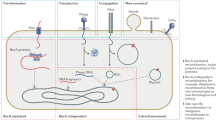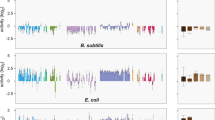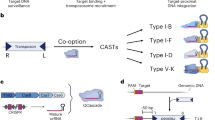Abstract
Integrons are genetic elements involved in bacterial adaptation which capture, shuffle and express genes encoding adaptive functions embedded in cassettes. These events are governed by the integron integrase through site-specific recombination between attC and attI integron sites. Using computational and molecular genetic approaches, here we demonstrate that the integrase also catalyses cassette integration into bacterial genomes outside of its known att sites. Once integrated, these cassettes can be expressed if located near bacterial promoters and can be excised at the integration point or outside, inducing chromosomal modifications in the latter case. Analysis of more than 5 × 105 independent integration events revealed a very large genomic integration landscape. We identified consensus recombination sequences, named attG sites, which differ greatly in sequence and structure from classical att sites. These results unveil an alternative route for dissemination of adaptive functions in bacteria and expand the role of integrons in bacterial evolution.
This is a preview of subscription content, access via your institution
Access options
Access Nature and 54 other Nature Portfolio journals
Get Nature+, our best-value online-access subscription
$29.99 / 30 days
cancel any time
Subscribe to this journal
Receive 12 digital issues and online access to articles
$119.00 per year
only $9.92 per issue
Buy this article
- Purchase on Springer Link
- Instant access to full article PDF
Prices may be subject to local taxes which are calculated during checkout






Similar content being viewed by others
Data availability
Fastq sequences of genomic cassette integration are publicly available in NCBI SRA (accession no. SRR23447848, SRR23447849 and SRR23447850). Bacterial genomes were directly downloaded from the NCBI RefSeq database (https://ftp.ncbi.nlm.nih.gov/genomes/refseq/). Source data are provided with this paper.
Code availability
All scripts used to quantify the ability of IntegronFinder 2.0 to detect SALINs are available at https://gitlab.pasteur.fr/hub/salin. The Nextflow pipeline used to analyse the raw fastq files and generate Fig. 4 and Extended Data Fig. 6 is available at https://gitlab.pasteur.fr/gmillot/14985_loot. The MarkDuplicates-Picard tool of GATK is available at https://github.com/broadinstitute/gatk. Bedtools used to extract sequence around integration sites is available at https://github.com/arq5x/bedtools2. IntegronFinder v.2.0.2 is available at https://github.com/gem-pasteur/Integron_Finder.
References
Stokes, H. W. & Hall, R. M. A novel family of potentially mobile DNA elements encoding site-specific gene-integration functions: integrons. Mol. Microbiol. 3, 1669–1683 (1989).
Escudero, J. A., Loot, C., Nivina, A. & Mazel, D. The integron: adaptation on demand. Microbiol. Spectr. 3, MDNA3-0019-2014 (2015).
Cury, J., Jove, T., Touchon, M., Neron, B. & Rocha, E. P. Identification and analysis of integrons and cassette arrays in bacterial genomes. Nucleic Acids Res. 44, 4539–4550 (2016).
Neron, B. et al. IntegronFinder 2.0: Identification and analysis of integrons across bacteria, with a focus on antibiotic resistance in Klebsiella. Microorganisms https://doi.org/10.3390/microorganisms10040700 (2022).
Buongermino Pereira, M. et al. A comprehensive survey of integron-associated genes present in metagenomes. BMC Genomics 21, 495 (2020).
Guerin, E. et al. The SOS response controls integron recombination. Science 324, 1034 (2009).
Baharoglu, Z. & Mazel, D. Vibrio cholerae triggers SOS and mutagenesis in response to a wide range of antibiotics: a route towards multiresistance. Antimicrob. Agents Chemother. 55, 2438–2441 (2011).
Richard, E., Darracq, B., Loot, C. & Mazel, D. Unbridled integrons: a matter of host factors. Cells https://doi.org/10.3390/cells11060925 (2022).
Bouvier, M., Demarre, G. & Mazel, D. Integron cassette insertion: a recombination process involving a folded single strand substrate. EMBO J. 24, 4356–4367 (2005).
Francia, M. V., de la Cruz, F. & Garcia Lobo, J. M. Secondary-sites for integration mediated by the Tn21 integrase. Mol. Microbiol. 10, 823–828 (1993).
Recchia, G. D., Stokes, H. W. & Hall, R. M. Characterisation of specific and secondary recombination sites recognised by the integron DNA integrase. Nucleic Acids Res. 22, 2071–2078 (1994).
Recchia, G. D. & Hall, R. M. Plasmid evolution by acquisition of mobile gene cassettes: plasmid pIE723 contains the aadB gene cassette precisely inserted at a secondary site in the incQ plasmid RSF1010. Mol. Microbiol. 15, 179–187 (1995).
Francia, M. V. & Garcia Lobo, J. M. Gene integration in the Escherichia coli chromosome mediated by Tn21 integrase (Int21). J. Bacteriol. 178, 894–898 (1996).
Segal, H. & Elisha, B. G. Identification and characterization of an aadB gene cassette at a secondary site in a plasmid from Acinetobacter. FEMS Microbiol. Lett. 153, 321–326 (1997).
Segal, H., Francia, M. V., Lobo, J. M. & Elisha, G. Reconstruction of an active integron recombination site after integration of a gene cassette at a secondary site. Antimicrob. Agents Chemother. 43, 2538–2541 (1999).
Souque, C., Escudero, J. A. & MacLean, R. C. Off-target integron activity leads to rapid plasmid compensatory evolution in response to antibiotic selection pressure. mBio 14, e0253722 (2023).
Loot, C., Bikard, D., Rachlin, A. & Mazel, D. Cellular pathways controlling integron cassette site folding. EMBO J. 29, 2623–2634 (2010).
Vit, C. et al. Cassette recruitment in the chromosomal Integron of Vibrio cholerae. Nucleic Acids Res. 49, 5654–5670 (2021).
Jove, T., Da Re, S., Denis, F., Mazel, D. & Ploy, M. C. Inverse correlation between promoter strength and excision activity in class 1 integrons. PLoS Genet. 6, e1000793 (2010).
Nivina, A., Escudero, J. A., Vit, C., Mazel, D. & Loot, C. Efficiency of integron cassette insertion in correct orientation is ensured by the interplay of the three unpaired features of attC recombination sites. Nucleic Acids Res. 44, 7792–7803 (2016).
Mazel, D., Dychinco, B., Webb, V. A. & Davies, J. A distinctive class of integron in the Vibrio cholerae genome. Science 280, 605–608 (1998).
Hyatt, D. et al. Prodigal: prokaryotic gene recognition and translation initiation site identification. BMC Bioinformatics 11, 119 (2010).
Omotajo, D., Tate, T., Cho, H. & Choudhary, M. Distribution and diversity of ribosome binding sites in prokaryotic genomes. BMC Genomics 16, 604 (2015).
Le Roux, F., Binesse, J., Saulnier, D. & Mazel, D. Construction of a Vibrio splendidus mutant lacking the metalloprotease gene vsm by use of a novel counterselectable suicide vector. Appl. Environ. Microbiol. 73, 777–784 (2007).
Betton, J. M. Cloning vectors for expression-PCR products. Biotechniques 37, 346–347 (2004).
Rousset, F. et al. Genome-wide CRISPR-dCas9 screens in E. coli identify essential genes and phage host factors. PLoS Genet. 14, e1007749 (2018).
Loot, C. et al. The integron integrase efficiently prevents the melting effect of Escherichia coli single-stranded DNA-binding protein on folded attC sites. J. Bacteriol. 196, 762–771 (2014).
Loot, C. et al. Differences in integron cassette excision dynamics shape a trade-off between evolvability and genetic capacitance. mBio https://doi.org/10.1128/mBio.02296-16 (2017).
Rutkai, E., Dorgai, L., Sirot, R., Yagil, E. & Weisberg, R. A. Analysis of insertion into secondary attachment sites by phage lambda and by int mutants with altered recombination specificity. J. Mol. Biol. 329, 983–996 (2003).
Tanouchi, Y. & Covert, M. W. Combining comprehensive analysis of off-site lambda phage integration with a CRISPR-based means of characterizing downstream physiology. mBio https://doi.org/10.1128/mBio.01038-17 (2017).
Crozat, E., Fournes, F., Cornet, F., Hallet, B. & Rousseau, P. Resolution of multimeric forms of circular plasmids and chromosomes. Microbiol. Spectr. https://doi.org/10.1128/microbiolspec.PLAS-0025-2014 (2014).
Kluyver, T. et al. Jupyter Notebooks—a publishing format for reproducible computational workflows. In Positioning and Power in Academic Publishing: Players, Agents and Agendas (eds Loizides, F. & Schmidt, B.) 87–90 (IOS Press, 2016).
McKinney, W. Data structures for statistical computing in Python. Proc. 9th Python Sci. Conf. 445, 51–56 (2010).
Cock, P. J. et al. Biopython: freely available Python tools for computational molecular biology and bioinformatics. Bioinformatics 25, 1422–1423 (2009).
Waskom, M. L. seaborn: statistical data visualization. J. Open Source Softw. 6, 3021 (2021).
Hug, L. A. et al. A new view of the tree of life. Nat. Microbiol. 1, 16048 (2016).
Biskri, L., Bouvier, M., Guerout, A. M., Boisnard, S. & Mazel, D. Comparative study of class 1 integron and Vibrio cholerae superintegron integrase activities. J. Bacteriol. 187, 1740–1750 (2005).
Demarre, G., Frumerie, C., Gopaul, D. N. & Mazel, D. Identification of key structural determinants of the IntI1 integron integrase that influence attC x attI1 recombination efficiency. Nucleic Acids Res. 35, 6475–6489 (2007).
Jaskolska, M., Adams, D. W. & Blokesch, M. Two defence systems eliminate plasmids from seventh pandemic Vibrio cholerae. Nature 604, 323–329 (2022).
Demarre, G. et al. A new family of mobilizable suicide plasmids based on the broad host range R388 plasmid (IncW) or RP4 plasmid (IncPa) conjugative machineries and their cognate E. coli host strains. Res. Microbiol. 156, 245–255 (2005).
Guzman, L. M., Belin, D., Carson, M. J. & Beckwith, J. Tight regulation, modulation, and high-level expression by vectors containing the arabinose PBAD promoter. J. Bacteriol. 177, 4121–4130 (1995).
Val, M. E., Skovgaard, O., Ducos-Galand, M., Bland, M. J. & Mazel, D. Genome engineering in Vibrio cholerae: a feasible approach to address biological issues. PLoS Genet. 8, e1002472 (2012).
Bouvier, M., Ducos-Galand, M., Loot, C., Bikard, D. & Mazel, D. Structural features of single-stranded integron cassette attC sites and their role in strand selection. PLoS Genet. 5, e1000632 (2009).
Langmead, B. & Salzberg, S. L. Fast gapped-read alignment with Bowtie 2. Nat. Methods 9, 357–359 (2012).
Wagih, O. ggseqlogo: a versatile R package for drawing sequence logos. Bioinformatics 33, 3645–3647 (2017).
de Lemos Martins, F., Fournes, F., Mazzuoli, M. V., Mazel, D. & Val, M. E. Vibrio cholerae chromosome 2 copy number is controlled by the methylation-independent binding of its monomeric initiator to the chromosome 1 crtS site. Nucleic Acids Res. 46, 10145–10156 (2018).
Madic, J. et al. Three-color crystal digital PCR. Biomol. Detect. Quantif. 10, 34–46 (2016).
Acknowledgements
We thank G. Macaux for experimental help; all the lab members for helpful discussion; M. Monot and L. Ma from the Biomics platform, C2RT, Institut Pasteur, Paris, France, supported by France Génomique (ANR-10-INBS-09) and IBISA. This work was supported by the Institut Pasteur, the Centre National de la Recherche Scientifique (CNRS-UMR 3525), the Fondation pour la Recherche Médicale (FRM Grant No. EQU202103012569; D.M.), ANR Chromintevol (ANR-21-CE12-0002-01; C.L.) and the French Government’s Investissement d’Avenir programme Laboratoire d’Excellence ‘Integrative Biology of Emerging Infectious Diseases’ (ANR-10-LABX-62-IBEID; D.M.).
Author information
Authors and Affiliations
Contributions
C.L. and D.M. designed the research. C.L., E.R., C.V., B.D., D.L., V.P., F.L. and T.N. performed the experiments. G.A.M. and F.L. performed the computational analysis of deep sequencing data. E.L., J.C., B.N. and E.P.C.R. performed the bioinformatics genomics analysis. C.L. and G.A.M. wrote the draft of the manuscript. All authors read, amended and approved the final version of the manuscript.
Corresponding author
Ethics declarations
Competing interests
The authors declare no competing interests.
Peer review
Peer review information
Nature Microbiology thanks Sandra Da Re, Louis-Marie Bobay and the other, anonymous, reviewer(s) for their contribution to the peer review of this work. Peer reviewer reports are available.
Additional information
Publisher’s note Springer Nature remains neutral with regard to jurisdictional claims in published maps and institutional affiliations.
Extended data
Extended Data Fig. 1 Random PCR approach used to determine the genome integration sites.
The genome integrated attC cassette is represented by a light grey arrow (coding sequence) followed by a dark grey triangle (attC). The red arrow indicates the integration site to determine. Primers used for the PCR amplification and sequencing are shown. Electrophoresis analysis of PCR products is shown. MW: Molecular Weight Marker, kb: kilobases.
Extended Data Fig. 2 Cassette recombination events mediated by IntI2 and IntI3 integrases.
The graph represents the recombination frequencies of attCaadA7 donor sites into attI and attCereA2 sites mediated by IntI2 and IntI3 integrases. The expressed integrases (IntI2 or IntI3) are indicated above the graph and the receptor sites in the axis-x legends. Bar charts show the mean of three independent experiments (n = 3, individual plots) and error bars show the standard deviation. Statistical comparisons (Student’s t test) are as follow: na. (not applicable); Grey asterisk (*) indicates the recombination frequency was below detection level.
Extended Data Fig. 3 Cassette integration events in genome in presence of an integron.
a, Experimental setup of the cassette integration assay (as in Fig. 3a). b, Electrophoresis migration of PCR products. Several PCR products are sequenced and the integration sites are indicated (att sites and gene location). c, Recombination frequencies of attCaadA7 donor sites into the att sites and genome. Integration sites are indicated in the axis-x legends. Bar charts show the mean of four independent experiments (n = 4, individual plots) and error bars show the standard deviation. Statistical comparisons (Student’s t test) are as follow: na. (not applicable); Grey asterisk (*) indicates the recombination frequency was below detection level. ts: thermosensitive; MW: Molecular Weight Marker, kb: kilobases.
Extended Data Fig. 4 Excision events observed for two genome-integrated cassettes.
a, Excisions occurring at the integration point (1) and reconstituting the mltA and ilvD genes are shown. Excisions occurring outside the integration point (2) inducing either genome deletion (excision point located in the genome) or insertion (excision point located in the integrated cassette) are shown. b, Sequences of the mltA and ilvD integration sites and of excision sites are shown. All the sequenced excision events (that is 64) are shown. Sizes in bps of each induced genome deletion (-) and insertion (+) are indicated. Cassette sequences are highlighted in grey and cleavage points are indicated by head of arrows. bps: base pairs.
Extended Data Fig. 5 Library construction for Deep sequencing.
All the steps of the library construction are indicated. Adaptors are represented by dark and light green rectangles. attC cassettes are represented by light grey rectangles (coding sequence) followed by dark grey triangles (attC).
Extended Data Fig. 6 Computational analysis of Deep sequencing data.
The figure shows the previous results obtained with IntI1 grouped with the new results obtained with IntI2 and IntI3. The legend is the same as in Fig. 4. The red boxes show the ybhO hotspot sites.
Extended Data Fig. 7 Digital PCR analysis of the oriC copy number relative to terC in E. coli recipient strain during a conjugation mimicking assay.
DNA extraction and PCR were performed at 0, 30, 60, 180 minutes (min) and at an overnight (O/N) time of incubation after the beginning of the conjugation. Bar charts show the mean of three independent experiments (n = 3, individual plots) and error bars show the standard deviation. Grey asterisk (*) indicates the recombination frequency was below detection level.
Extended Data Fig. 8 Analysis of the attG integration site motifs.
a, Consensus sequence of the six highest hotspot integration sites. A total of 20 bases around the cleavage point was inputted into the WebLogo program (http://weblogo.berkeley.edu/) to generate the motif. The cleavage occurs between the -1 and 1 bases. Bits refers to the information content. b, Recombination frequencies of attCaadA7 donor sites into the mutated ybhO hotspot and attI1 sites. The 4 nucleotide sequences indicated in the axis-x legends correspond to the position 6 to 9 given that position -1 corresponds to the G of the cleaved triplet site. The wt ybhO and attI1 sites are indicated in red at the top of the bars. Bar charts show the mean of three independent experiments (n = 3, individual plots) except for ybhO wt CAGC (with IntI1) for which n = 8. Error bars show the standard deviation. Statistical comparisons (Student’s t test) are as follow: ns. (not significant); all two-sided. Grey asterisk (*) indicates the recombination frequency was below detection level.
Extended Data Fig. 9 Determination of the attG recombination nature.
a, Single or double cleavage of attG sites?. Double cleavage: we expect heterogeneity of products due to the repair process. Single cleavage: we expect homogeneity of products due to the replication process. b, Bottom or top strand cleavage of attG sites?. Bottom strand cleavage: we expect an orientation + (light brown arrow) and a functional attC site. Top strand cleavage: we expect an orientation - (dark brown arrow) and a non-functional attC site. attG containing replicons are represented by dark lines and attC cassettes by grey ones. The precise cleavage point is indicated by a red arrow. ss and ds: single and double-stranded; bs: bottom strand.
Supplementary information
Supplementary Table 1
Strains, transformed strains, plasmids and primers used in the present study.
Source data
Source Data Fig. 2
IntegronFinder data.
Source Data Fig. 3
Conjugation and excision assay results used for statistical analysis.
Source Data Fig. 5
Conjugation assay results used for statistical analysis.
Source Data Extended Data Fig. 2
Conjugation assay results used for statistical analysis.
Source Data Extended Data Fig. 3
Conjugation assay results used for statistical analysis.
Source Data Extended Data Fig. 7
Digital PCR data.
Source Data Extended Data Fig. 8
Conjugation assay results used for statistical analysis.
Unprocessed gels
Unprocessed gels from Extended Data Figs. 1 and 3.
Rights and permissions
Springer Nature or its licensor (e.g. a society or other partner) holds exclusive rights to this article under a publishing agreement with the author(s) or other rightsholder(s); author self-archiving of the accepted manuscript version of this article is solely governed by the terms of such publishing agreement and applicable law.
About this article
Cite this article
Loot, C., Millot, G.A., Richard, E. et al. Integron cassettes integrate into bacterial genomes via widespread non-classical attG sites. Nat Microbiol 9, 228–240 (2024). https://doi.org/10.1038/s41564-023-01548-y
Received:
Accepted:
Published:
Issue Date:
DOI: https://doi.org/10.1038/s41564-023-01548-y



